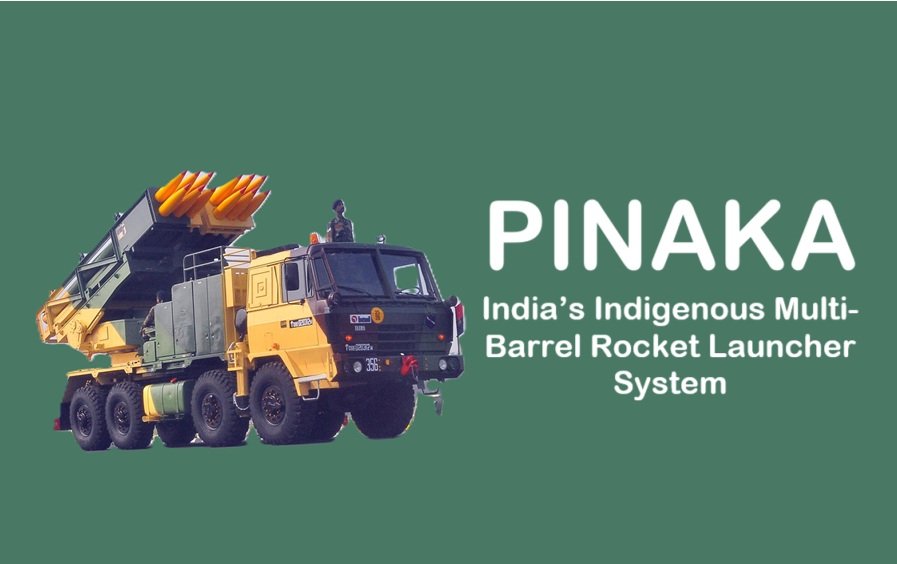
India’s quest for self-reliance in defense technology has led to the development of several indigenous weapons systems. Among them, the Pinaka Multi-Barrel Rocket Launcher (MBRL) system stands out as a formidable asset in India’s artillery arsenal. Named after the bow of Lord Shiva, Pinaka exemplifies a blend of technological innovation, strategic capability, and combat readiness, reinforcing India’s firepower along its borders.
1. Introduction to the Pinaka System
The Pinaka is a long-range, multi-barrel rocket launcher system developed by the Defence Research and Development Organisation (DRDO) for the Indian Army. Designed to deliver rapid and concentrated firepower across vast areas, Pinaka is a mobile weapon system capable of firing a salvo of rockets in a matter of seconds.
The system is used for neutralizing large areas of enemy troops, light armored vehicles, radar installations, and communication centers, particularly during the early stages of conflict to soften targets before infantry movement.
Read This: BrahMos Missile: The Supersonic Cruise Missile Powering India’s Defense
2. Historical Development
Early Concept and Need
The idea for Pinaka was conceived in the 1980s after the Indian Army identified the need for a more advanced and indigenous replacement to the aging Soviet-era BM-21 Grad rocket launchers. The goal was to have a high-impact, long-range artillery system developed in India.
Development Timeline
- 1986: DRDO initiated the development project.
- 1990s: First successful field trials were conducted.
- 1999: During the Kargil War, Pinaka was used operationally in limited capacity.
- 2000s: The system underwent further refinements and improvements.
- 2006: Pinaka was officially inducted into the Indian Army.
3. System Overview
The Pinaka system includes multiple components, all integrated for high mobility and accuracy.
Key Components
- Launcher Vehicle: Mounted on an 8×8 Tatra truck, each launcher has 12 rocket tubes capable of firing a full salvo in 44 seconds.
- Loader-Cum-Replenishment Vehicle: Carries additional rockets and aids in quick reloading.
- Command Post Vehicle (CPV): Equipped with fire control computers and communication gear.
- Meteorological Vehicle: Provides real-time weather data to adjust trajectory and accuracy.
4. Variants of Pinaka
Over time, several variants of the Pinaka system have been developed to suit various operational requirements:
Pinaka Mk-I
- Range: 37.5 – 40 km
- Warhead Types: High explosive, incendiary, anti-tank mine, and cluster munitions
- Salvo Capability: 12 rockets in 44 seconds
Pinaka Mk-II
- Range: Up to 75 km
- Guidance: Enhanced navigation and accuracy through GPS/INS-based guidance systems
- CEP (Circular Error Probability): Reduced, for pinpoint accuracy
Pinaka Mk-I Enhanced
- Range: ~45 – 60 km
- Accuracy: Improved accuracy over Mk-I, but not as guided as Mk-II
Guided Pinaka (G-Pinaka)
- Uses satellite navigation systems (GPS/IRNSS) for guidance
- Precision-strike capability with 10m CEP
- Designed for high-value target neutralization
5. Capabilities and Firepower
- Rapid Fire: A battery (6 launchers) can launch 72 rockets in under 45 seconds, saturating an area of 1,000 m x 800 m.
- Mobility: Mounted on high-mobility vehicles, Pinaka is highly mobile and deployable in diverse terrains including deserts, mountains, and high-altitude zones.
- Automation: Equipped with automated command and control systems, GPS-based navigation, and real-time data link for coordination.
6. Strategic Significance
Kargil War Use Case
Though still in limited use at the time, the Pinaka system played a minor but impactful role during the Kargil War. It demonstrated the value of rapid saturation fire in mountainous regions, prompting the Indian Army to accelerate its induction.
Make in India Initiative
Pinaka is a flagship success under the Make in India campaign. It showcases India’s ability to not only design and develop but also manufacture advanced defense systems domestically.
Export Potential
With its successful deployment and upgrades, Pinaka is now being offered for export to friendly nations. Its cost-effectiveness and indigenous nature make it an attractive option for countries seeking advanced rocket artillery without relying on Western or Chinese systems.
7. Collaborations and Private Sector Involvement
While DRDO developed the system, manufacturing and supply have been largely handed over to Indian private defense companies, including:
- Tata Advanced Systems
- Larsen & Toubro (L&T)
- Bharat Forge
- Solar Industries
This public-private collaboration ensures scalability, cost efficiency, and timely delivery to the Indian Army.
8. Comparison with Global Systems
| System | Country | Max Range | Type | Notes |
|---|---|---|---|---|
| Pinaka Mk-II | India | 75 km | MBRL | Guided variant in service |
| HIMARS | USA | 80+ km (GMLRS) | MBRL | Used in Ukraine, GPS-guided |
| BM-30 Smerch | Russia | 90 km | MBRL | India also uses Russian Smerch |
| AR1A | China | 130 km | MBRL | Used by PLA |
While the Pinaka Mk-II may have a shorter range than some top-end systems like the Russian Smerch or Chinese AR1A, its precision, mobility, and indigenous production offer distinct strategic advantages.
9. Future Developments
- Extended Range (ER) Variants: DRDO is working on further enhancing the range up to 120 km.
- Pinaka Rockets with Loitering Munitions: Combining Pinaka’s delivery system with loitering capabilities is under exploration.
- Integration with UAVs and ISR Platforms: For better targeting, real-time battlefield awareness, and coordination.
10. Conclusion
The Pinaka Multi-Barrel Rocket Launcher is more than just a weapon system — it is a testament to India’s defense innovation and indigenous capability. With continuous upgrades and operational use, Pinaka is playing a pivotal role in shaping India’s modern battlefield tactics. Its ability to deliver devastating firepower with precision, speed, and mobility makes it a cornerstone of India’s artillery modernization program.
As India continues to strengthen its defense preparedness, systems like Pinaka will ensure that the country maintains a decisive edge in conventional warfare, while reinforcing the larger vision of Atmanirbhar Bharat (Self-Reliant India) in defense manufacturing.







